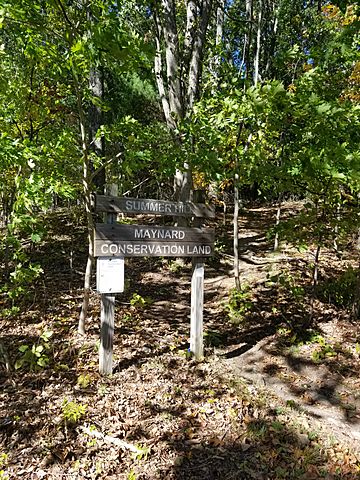Summer Hill (Maynard, Massachusetts) facts for kids
Quick facts for kids Summer Hill |
|
|---|---|

Summer Hill Conservation Land trailhead on Summer Hill Road
|
|
| Highest point | |
| Elevation | 348 ft (106 m) |
| Prominence | 250 ft |
| Naming | |
| English translation | land of many hills |
| Geography | |
| Location | Maynard, Massachusetts, United States |
| Climbing | |
| Easiest route | Summer Hill Conservation Land paths |
Summer Hill is a special place in Maynard, Massachusetts. It's also known by its older names, Pompasitticut or Pomciticut. This hill stands about 351 feet (107 meters) tall. It looks over the Assabet River. Summer Hill is the highest point in Maynard.
Today, much of the hill is protected as conservation land. This means it's a natural area for everyone to enjoy. You can find public hiking trails there. At the very top of the hill, there's a radio tower. You can also see the town's large water tanks made of steel and concrete.
Contents
Exploring Summer Hill's Past
Summer Hill has a long and interesting history. It has been important to people for hundreds of years.
Native American History
Long ago, Native Americans lived in this area. They called both the hill and the surrounding land "Pompasitticut." This name means "land of many hills." It describes the area perfectly.
In the 1660s, an early settler named John Kettell likely lived near Pompasitticut Hill. This was before a big conflict called King Philip's War. During this war in 1676, Native Americans gathered on Pompasitticut Hill. They were said to have planned an attack on Sudbury from this spot.
Early Farm Life and Land Use
From 1683 until 1871, Summer Hill was part of the town of Stow. For many years, it was used as common land for the town. People often used it as a pasture for their animals.
The Gibson family owned a large farm on the hill. They lived there from the 1720s until 1823. Later, in 1826, the Maynard family bought the farm. This farm was known as "Summer Hill Farm." It was on the south side of Pomposetticutt Hill. Many old Native American items were found there. Lucius H. Maynard collected a lot of these interesting relics.
Henry David Thoreau's Visit
On April 18, 1859, a famous writer named Henry David Thoreau visited the hill. He was surveying a woodlot near the hill for a sale. Thoreau wrote about Summer Hill in his writings about wild blueberries. He mentioned how cutting down trees on the hill "deforms a hillside." But he also noted that villagers got "compensation in the crop of berries" that grew there.
Maynard Becomes a Town
In 1871, Maynard became its own independent town. To celebrate, citizens raised a flag pole on Pompsiticut Hill. This was a big event for the new town.
By 1891, the hill was still very important. The north and west sides had "excellent orchard and plow-lands." This means they were good for growing fruit trees and crops. The south side had "a fertile valley" and "fine pasturage" for animals.
At the top of the hill, a reservoir was built in 1888. A reservoir is a place to store water. From the summit, people had clear views. They could see Mount Wachusett and Mount Monadnock in New Hampshire. Erickson's Dairy, which started in 1937, used milk from cows that grazed on Summer Hill.
Protecting Summer Hill Today
In the early 1900s, there were plans to build houses on Summer Hill. However, these plans never happened. In 1979, the Conservation Commission bought a large part of the land. They wanted to protect it as open space.
Today, Summer Hill has public hiking trails. You can find the start of these trails, called trailheads, on Summer Street and Summer Hill Road. Look for the Conservation Land signs to begin your adventure!
Images for kids








